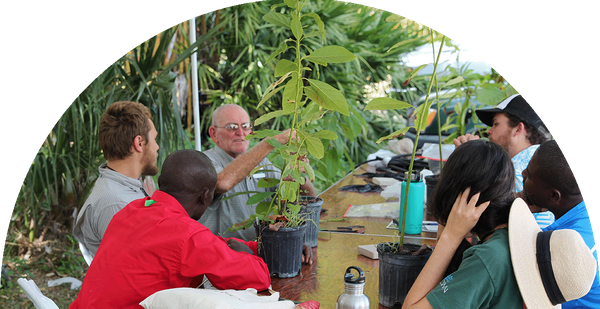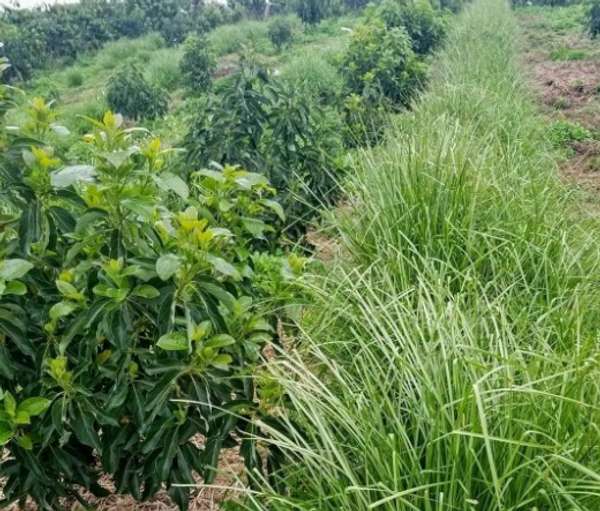ECHOcommunity Updates
Triage and Recovery of Small Trees Toppled by Storms 2022-10-25
Hurricane Ian felled many trees on ECHO’s Global Demonstration farm in southwest Florida. A tree blown over by strong winds can be recovered if most of the roots remain attached to the trunk. Tim Motis shared ECHO's step-by-step process that ECHO successfully used following Hurricane Irma, and have implemented after Hurricane Ian. The process could apply to other storm-affected areas and be adapted based on available materials. You may have your own techniques and experiences with downed trees. Please share your experience, knowledge and ideas with the ECHO Community!
EDN Numéro 157 Maintenant disponible 2022-10-24
Sommaire:
- Le point sur l’engrais bioliquide
- Considérations sur la sélection des cultures
- Échos de notre réseau: Liquide fermenté de Tithonia et de neem pour lutter contre les termites
- De la Banque de semences de ECHO: «Asia Cayenne»: Un piment au goût doux
- Livres, sites Web et autres ressources: Ressources VITA réactivées revived et La carte de recommandations d’engrais et de semences pour l’Afrique de l’Ouest
Le point sur l’engrais bioliquide
Tim Motis et Stacy Swartz
Extrait:
Les niveaux d’azote ont atteint leur maximum entre deux (tithonia) et trois (à base de fumier) semaines après la fabrication de l’engrais. La plupart des autres éléments nutritifs ont atteint leurs niveaux les plus élevés à la cinquième semaine. Ces tendances indiquent que le moment optimal pour appliquer l’EBL est plus précoce (2 à 3 semaines, selon la formulation) pour l’azote que pour les autres éléments nutritifs. Des facteurs tels que la température, la rigueur du mélange et la manipulation des échantillons peuvent avoir eu une incidence sur les valeurs de la teneur en éléments nutritifs au cours des semaines d’échantillonnage.
EDN Número 157 Disponible Ahora 2022-10-24
Temas de Relieve:
- Actualización sobre biofertilizantes líquidos
- Consideraciones para la selección de cultivos
- Ecos de nuestra red: Tithonia y líquido fermentado de neem para control de las termitas
- Del Banco de Semillas de ECHO: ‘Cayena asiática’: Un chile (ají) de suave sabor
-
Libros, sitios web y otros recursos: Nueva vida para recursos de VITA y Mapa de recomendaciones de fertilizante y semilla para África Occidental
Actualización sobre biofertilizantes líquidos
Tim Motis y Stacy Swartz
Excerpto:
El biofertilizante líquido (BLF por sus siglas en inglés; también conocido como fertilizante líquido orgánico) es popular entre la red de ECHO y pequeños productores de todo el mundo. La preparación de este fertilizante es más fácil que la de otras enmiendas en la finca, como el compost, y se adapta con facilidad. ECHO fomenta el uso de opciones de abono y plantas disponibles en el ámbito local. Al reconocer la necesidad de información sobre la composición de nutrientes del BLF, nosotros (el personal de ECHO en Florida) creamos dos formulaciones de BLF y las muestreamos durante un período de tiempo para analizar los nutrientes. Este artículo resume nuestros resultados, que arrojan luz sobre cuándo aplicar BLF y las cantidades de nutrientes con y sin estiércol.
Upcoming ECHO International Agriculture Conference Sessions 2022-10-18
Walk through Biochar Production Case Studies with Barry Gutwein. There are many challenges associated with handling feedstock, controlling pyrolysis, managing the heat, and stabilizing the produced biochar. Learn how we have adapted biochar systems to a variety of countries and contexts.
Get an introduction to the practical basics of Integrated Pest Management with Annie D. Come learn the basics of entomology and insect behavior as it relates to managing insect pests in settings ranging from a home garden to a larger farm. Following an indoor presentation, we'll explore ways that we can control insects using a holistic, integrated, approach as we walk around the farm. We'll look for different insect pests and talk about ways to recognize and manage them in a holistic way.
Other Sessions include:
- Establishing Fruit Trees
- Bamboo Basics
- Teaching Survival Gardening
- Grafting
- Water Irrigation Systems
- Team Management Techniques
- Community Gardening
- Processes for Crop Selection
- Perennial Greens for Increased Nutrition
EDN #157 Now Available 2022-10-02
In this issue:
- Bioliquid Fertilizer Update
- Considerations for crop selection
- Echoes from our Network: Tithonia and neem fermented liquid for termite control
- From ECHO's Seed Bank: ‘Asia Cayenne’: A Mild-Tasting Chili Pepper
- Books, Websites, and Other Resources: VITA resources revived and The Fertilizer and Seed Recommendations Map for West Africa
Bioliquid Fertilizer Update
Tim Motis and Stacy Swartz
Excerpt:
Another factor to consider when diluting is the stage of the crop. Young seedlings are more sensitive to leaf burn caused by high salts than more established plants and therefore require more dilution (to lower the amount of BLF in relation to water) early on. Plants entering reproductive stages (flowering and fruiting) require less macronutrients than they did during vegetative stages (leaves and stem growth). After flowering, you could decrease or halt application of the fertilizer entirely.
Preview ECHO Conference Session Topics 2022-09-06
The Vetiver System:
A toolkit in support of community-led climate change adaptation.
As the globe adjusts to changing climate conditions, communities must be empowered with practical, affordable, and effective tools, as well as with the knowledge and capacity to apply and manage them. The Vetiver System offers a multipurpose toolkit of over thirty different eco-engineering applications. Jim Smyle of Vetiver Network International will share the vision of The Vetiver System and how it's changing livelihoods in the global South.
VITA resources revived on ECHOcommunity 2022-08-30
Originally published by Volunteers in Technical Assistance between 1959 and 2005, ECHOcommunity has recently rereleased 137 documents in 6 languages for the benefit of community development globally. Volunteers in Technical Assistance (VITA) started in 1959 and aligned with ECHO’s beliefs that sharing knowledge is key to lasting community development. Through the years, VITA published a wide range of practical guides and how-to’s, from a few pages to complete manuals of 200 pages and more, featuring clear instructions and easy-to-follow plans and illustrations. These useful guides cover topics such as agriculture and animal husbandry, building and construction, business, industry and crafts, communication and transportation, energy, food processing, health and nutrition, stoves, ovens and kilns, water supply, natural resources, and conservation. As businesses or organizations change over time, sometimes organizations serving in the international development space have merged with other groups or changed objectives, resulting in the loss of access to books and research that still have value today. At ECHO, we revive access to resources that might have value within the ECHOcommunity network. Research revealed that VITA had been merged with other organizations over time and that many of the historical resources were no longer readily accessible online. ICT Specialist Steve Snyder reached out to the organization and received a positive response to the idea of ECHO hosting a repository of historical VITA documents for the benefit of community development globally. In this case, an impressive collection of 137 VITA documents in 6 languages (English, French, German, Italian, Portuguese, and Spanish) have been republished. This list includes titles like:
- Understanding Evaporative Cooling,
- Candle Making,
- Understanding Pedal Power,
- Solar Water Heaters,
- Raising Chickens and Ducks, and
- Understanding Agroforestry.
View the list of VITA Resources
Composting Coffee Chaff (Silverskin) 2022-08-23
Coffee silverskin is high in nutrients, but contains recalcitrant and phytotoxic compounds, limiting its use as a mulch or soil amendment. Fortunately, composting can reduce or eliminate these problems. Composting has been shown to degrade the phytogenic compounds in coffee silverskin, providing a route for safely returning coffee silverskin nutrients to the soil. Picca et al. (2022) have shown that composting with garden prunings, and biochar eliminated phytotoxicity while making nitrogen readily available. Gonzalez-Moreno et al. (2020) demonstrated a similar outcome with vermicomposting. However, they noted that coffee silverskin can be toxic to worms in high concentrations.
Meet two keynote speakers for ECHO's 29th annual International Agricultural Conference 2022-08-09
Joyce Njoro
Joyce Njoro serves on the Nutrition and Social Inclusion team at the International Fund for Agricultural Development (IFAD). She leads the organization in agriculture-nutrition linkages and rural development investments, targeting smallholder farming families. Joyce has extensive experience in government policy and the intersection of education, agriculture, and healthcare.
Jack Shoemaker
Dr. Jack Shoemaker grew up in Bolivia alongside indigenous people groups as his parents were Bible translators. He has worked with Amazonian peoples and Sudanese families through community development and teacher training. Jack uses his experience and passion for Linguistics and Anthropology to teach at Dallas International University focusing on balancing cultural systems with Biblical exegesis.
Bioliquid Fertilizer Update 2022-08-02
Bioliquid fertilizer (BLF; also known as organic liquid fertilizer) has become popular with ECHO’s network and smallholder farmers around the world. ECHO West Africa introduces and instructs on how to prepare this amendment in ECHO West Africa Note 1 (Sié Kansié, 2017). In March 2022, we made BLF as outlined by Sié Kansié, 2017 with the utilization of pigeon manure and the new growth (leaves and stems) of Mexican sunflower (Tithonia diversifolia). See some of our preliminary results and share your experience with bioliquid fertilizer on ECHO Conversations today! A more in-depth analysis of this natural fertilizer will be shared in October's issue of ECHO Development Notes.
.jpeg?w=600)







